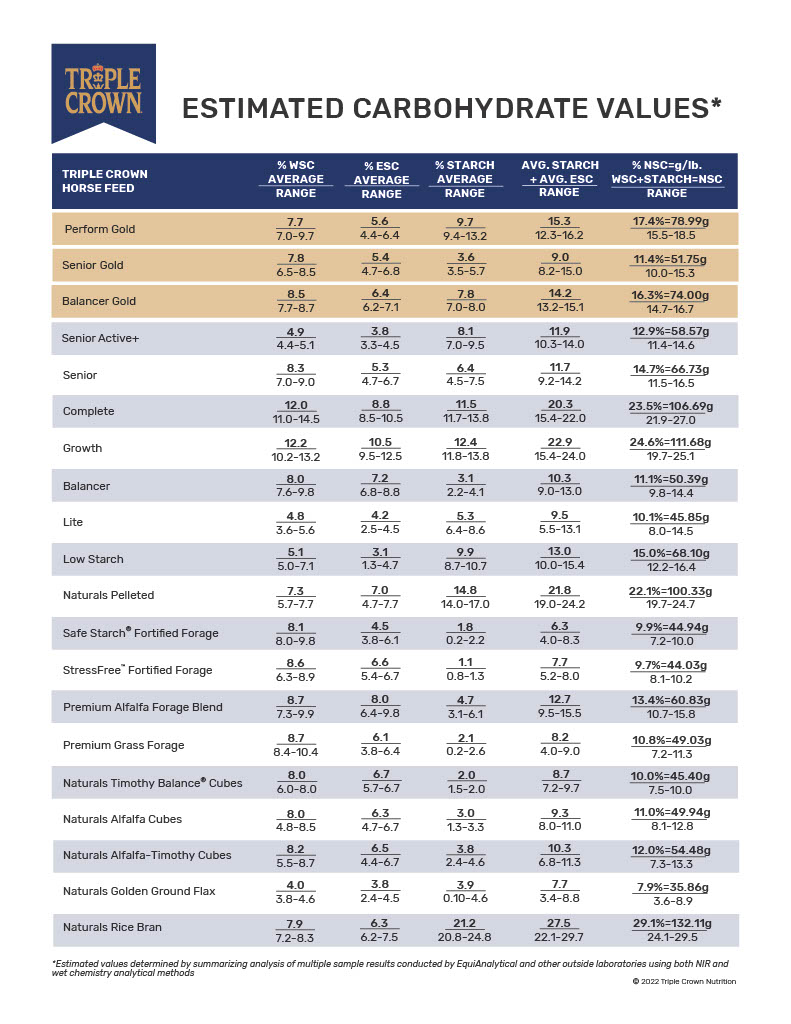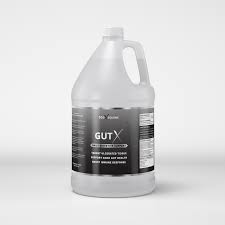Interpreting Triple Crown’s Ever ChangingNSC Chart

“Here goes Jim picking on Triple Crown again!”
Keep reading because I think I just figured out how to define my attitude towards feed and supplement companies.
I’m not really “anti” any feed or supplement company but rather I’m “anti marketing”.
Marketing is a method in which a company presents its products in an appealing way or by offering something better than the competition.
This is just fine with me as long as the marketing is based on the entire truth.
Before we dive into the subject of Triple Crown and NSC I would ask that before you jump to the defense of your favorite feed company you read this all the way to the end because you will see that rather than disparaging a very good feed my issue is that their marketing department is doing a very good feed a very large disservice.
This article itself will prove my point since it has taken six pages to explain the Triple Crown NSC chart while I can provide you the answer to NSC in other feeds in a single line.
A Brief Review of NSC Reporting
I have covered this topic in detail on my blog and in the FB group dozens of times but for the purpose of context I’ll hit the bullet points.
NSC is not a direct value measurable by testing. Dietary starch and sugars are measurable through testing and NSC is derived from those values. There is some argument over which of the dietary starch values to use but read one of my articles if you want to know more.
AAFCO is the organization that standardizes guideline used by a state’s department of agriculture to determine the compliance of the feed in the bag with the stated guaranteed nutrition analysis printed on the feed tag.
NSC is not recognised by AAFCO and therefore not by a department of agriculture doing testing.
A lab can only test for dietary starch and sugar and that is how the NSC values are expressed on the feed tag.
Dietary Starch and Sugar are expressed as percentage of volume and are guaranteed as MAXIMUM.
These values ARE NOT MANDATORY to be guaranteed so it is purely optional for a company to include them. AAFCO passed a resolution making these mandatory reporting values if a feed company makes any claims of NSC or starch in their marketing but Oregon is the only state that adopted it and they aren’t really enforcing it.
To sum it up…
NSC isn’t a measurable value for agricultural testing
Unless Dietary Starch and sugar are expressed on the feed tag they are not enforceable.
The Problem With Averages
If you stand with one foot in boiling water and the other in ice water the average temperature is 122 degrees or about what you shower at, comfortably warm.
The reality is that one foot is freezing and one foot is boiling. Neither sensation is pleasant.
Triple Crown presents an elaborate chart offering “full disclosure” on their NSC calculations but they place an emphasis on “AVERAGE” NSC. Average NSC doesn’t help me when I’m trying to make decisions for my metabolic horse.
I’m going to take you all back to my glory days of being a swave and deboner aviator for a brief diversion.
“Airspeed is life” is the first rule a pilot learns and the charts are full of them. The reference for airspeed is “V” for velocity. Vx, Vy, Vse, there are all kinds of V speeds pilots memorize. In fact for every aircraft ever built the manual includes Vref charts that we used to have to memorize. But the one V speed all pilots remember above all is Vne. Velocity to never exceed.
Vne in my little Loach (google that word if you’re interested) was 130 knots. That number meant that the engineers at Hughes Tool and Die company guaranteed me with all their professional hearts that as long as I held my indicated airspeed below 130 knots that lovely tiny jewel of a helicopter wouldn’t come apart in my hands.
130 was the MAX safe airspeed for that aircraft. How good would that speed be if it were an “average”.
“Well, Jim, it looks like somewhere around 130 bad shit can happen. Could break up at 110 or might stay together up to 150.” No help at all.
There was some “fudge factor” built in for gramma Fiorini because my helicopter was already 12 years old when I got it and had been shot down twice in Vietnam but I trusted the engineers.
I shared this for fun and for emphasis so that you understand my prickliness when it comes to numbers. Pilots (and their passengers) literally place their lives in the hands of numbers.
Perception is Reality
The very first words out of the teacher’s mouth on my first day of Marketing 101 were, “Always remember that perception is reality and it is the job of marketing to alter the consumer’s perception of your product”.
The general perception of Triple Crown Senior is that it is the gold standard by which all feeds are measured.
It is grain free (not true)
It is a complete feed (not true)
It has the lowest NSC of any feed (definitely not true)
Triple Crown isn’t “lying” about any of these “perceptions” but their marketing alters the perception of the feed’s primary demographic.
This article is only going to focus on NSC because none of the rest of the stuff really matters. I don’t care if they split hairs on “grain free” (believed) and “WHOLE grain free” (accurate statement).
The Truth About Triple Crown NSC
Triple Crown has gone through several versions of NSC charts posted on their website in the past three years. These changes have been a direct result of pressure from the members of my Facebook group trying to nail the company down on the matter.
My biggest objection, if not my only objection to recommending Triple Crown is their adamant refusal to put Starch and Sugar on their guaranteed analysis.
Indeed, I have spent hours on the phone and in online forums causing various representatives of Triple Crown to explain the rationale behind not offering these values yet at the same time “guaranteeing” them.
I’ve heard every excuse possible from testing variables to there’s no clear definition of NSC. My response to each one of their reasons is simple…
“If that’s the case why do Purina, Cargill, Buckeye and other feed companies print starch and sugar on their guaranteed analysis?”
The answer is always the same, “We can’t speak for other companies”.
My smart ass reply? “There’s no need because the other companies have spoken by their actions”.
This typically ends the conversation.
I am going to focus on the original Triple Crown Senior for this article because it is the original feed, it is very popular and it is an excellent feed choice…if they guaranteed NSC.
If we reference the current NSC chart for Triple Crown feeds you will notice that it is very complete, read as complicated.
As a marketing tactic “full disclosure” is one of the best. Publish everything and you’re off the hook. Just put it out there and allow the consumer to decide.
That’s just great but the average consumer isn’t going to be able to make sense of this chart let alone understand it.
The chart provides every scenario of possible NSC combinations. It also brings in the argument of WSC versus ESC when calculating NSC. It’s long and complicated but WSC includes fructans which aren’t absorbed in the small intestine but DO ferment in the hindgut causing all kinds of trouble.
The reason companies that are looking for low NSC numbers as a marketing tool use ESC is that it will lower the NSC value by 3 points or more.
I ALWAYS use WSC for NSC calculations because some carbs are transient and some ESC will end up in WSC in the lab.

Anyway…
The chart has 4 columns, ESC, WSC, STARCH, ESC+STARCH, WSC+ STARCH.
The confusion is added to because in each column there is an average value above the range of values used to determine the average.
Still with me? Hang on.
Before we get into the specific numbers it is important to understand how averages are calculated. The more samples included the more accurate the average calculated.
There is a note at the bottom of the chart stating “values derived from testing results from EquiAnalytical and other sources”. AWESOME!! How many? 10, 30, 1,227?
An average only requires two values to be calculated. Add those two together and divide by two and you get an average. Not a very accurate average but it’s an average.
When you look at EquiAnalyticals database for nutritional values of grass hay they tell you that the averages were derived from 5,227 samples. THAT average is accurate and is meaningful.
I’m not going to go through the entire chart because nobody needs a math lesson so let’s just jump to the last column, WSC+STARCH = NSC.
The AVERAGE is 14.7% NSC but the range of samples is 11.5% on the low end to 16.5% on the high end. This tells us that out of all the samples the highest value tested was 16.5%.
Remember Vne of 130 knots indicated airspeed that I bet my life on every day for 5 years? This is the same thing except I’m betting my metabolic horse’s life on this value.
If I put it to you in those terms are you going to count on the Average NSC, ESC + Starch of 11.7% OR are you going to bet your metabolic horse’s life on the maximum possible NSC in the feed of 16.5%?
Because that’s what maximum means. Is the feed in your bag PROBABLY 11.7% NSC? Yes, probably close. Is it possible that it could be as high as 16.5%? Goddamned right it could be.
Keep that MAXIMUM VALUE of 16.5% handy because it’s going to become really significant really soon.
The Disservice of Marketing
So how is the Triple Crown marketing department doing this very good feed a very large disservice?
Instead of just coming right out and telling you that the MAXIMUM NSC value in Triple Crown Senior (or any of their feeds for that matter) is going to be 16.5% guaranteed so that you can bet your metabolic horse’s life on it marketing chooses to publish an accurate chart with full transparency that is so complicated the average owner isn’t going to take the time to understand it but a TC rep can point to the number of 11.7% and with good conscience proclaim that this is the AVERAGE NSC value of TC Senior.
Dear Triple Crown rep, you know and I know you know that a consumer is going to feel confident that the gospel NSC for Triple Crown Senior is 11.7%.
I’m not sure you can call it lying but if it’s not misleading I have never before been misled.
Would you like to know what’s really sad about this whole thing?
Well, for starters 16.5% as a MAXIMUM NSC value is actually pretty manageable for virtually any metabolic horse when fed properly so TC Senior is a perfectly acceptable feed for these horses.
As it so happens another great concentrated senior feed that is a virtually identical formulation is Purina Equine Senior Active. Before I reveal the ugly truth does anyone care to guess what the GUARANTEED MAXIMUM NSC of Purina Senior Active is?
Wait for it…16.5%!!!! Guaranteed and printed right on the feed tag for the whole world to see.
The problem is that TC’s marketing department has to find ways to charge you $2.00 a bag more for their feed so it’s important to make you think it’s a better feed when it really isn’t.
To put this all into a nice, clean enchilada my last question for you is…
When you ask how much NSC is in a feed and you get two answers…
“Well, the average NSC is 11.7% but if you look at the chart it depends on what sample data and what formula you use but check it out. Jim the Feed Guy wrote an entire article on how to interpret the results”
OR
“The total maximum NSC in this feed is 16.5%. It is formulated for a lower value but the most it will ever be is 16.5%”
Which feed are you going to choose?
I’ve stated my professional advice many times. I don’t care how good a feed is if you are concerned with NSC for your horses and a feed doesn’t list Dietary Starch and Sugar as part of their guaranteed analysis on the feed tag DO NOT FEED IT.


0 Comments